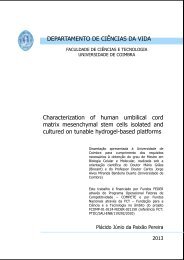role of th1 and th17 cd4+ t cell subsets in the pathogenesis of ...
role of th1 and th17 cd4+ t cell subsets in the pathogenesis of ...
role of th1 and th17 cd4+ t cell subsets in the pathogenesis of ...
You also want an ePaper? Increase the reach of your titles
YUMPU automatically turns print PDFs into web optimized ePapers that Google loves.
Figure 1.2 – CD4 + helper T <strong>cell</strong> differentiation [adapted from (Wilson et al., 2009)]<br />
IL‐12 is a heterodimeric cytok<strong>in</strong>e formed by a large (p40) <strong>and</strong> a small (p35) glycosylated<br />
<strong>and</strong> disulfide‐l<strong>in</strong>ked subunits to form <strong>the</strong> bioactive IL‐12 (p70). IL‐23 was not long ago<br />
described <strong>and</strong> is also a heterodimeric cytok<strong>in</strong>e that shares with IL‐12 <strong>the</strong> p40 subunit<br />
plus a smaller subunit, p19 (Oppmann et al., 2000). The discovery <strong>of</strong> IL‐23 led to <strong>the</strong><br />
identification <strong>of</strong> Th17 <strong>cell</strong>s as ano<strong>the</strong>r dist<strong>in</strong>ct CD4 + T <strong>cell</strong> l<strong>in</strong>eage, which is <strong>in</strong>duced by IL‐<br />
23 <strong>and</strong> <strong>in</strong>hibited by IFNγ <strong>and</strong> IL‐4 (Harr<strong>in</strong>gton et al., 2005). However, later studies shed<br />
doubt on IL‐23 as <strong>the</strong> true driv<strong>in</strong>g force <strong>of</strong> <strong>the</strong> de novo differentiation <strong>of</strong> Th17 <strong>cell</strong>s, <strong>and</strong><br />
suggested <strong>in</strong>stead that Th17 <strong>and</strong> Tregs <strong>cell</strong>s are closely l<strong>in</strong>ked by TGFβ1. While Tregs,<br />
32

















